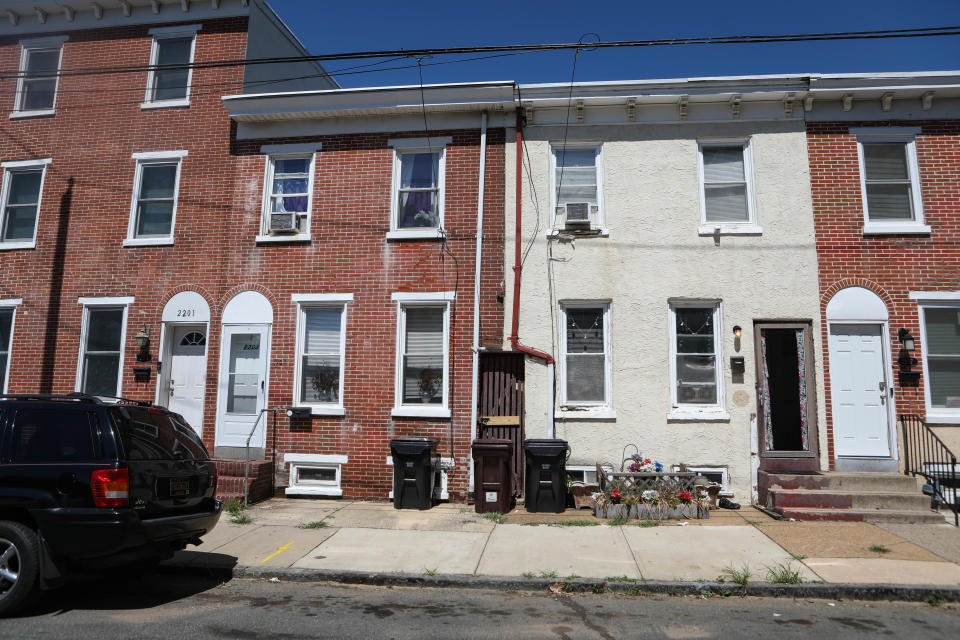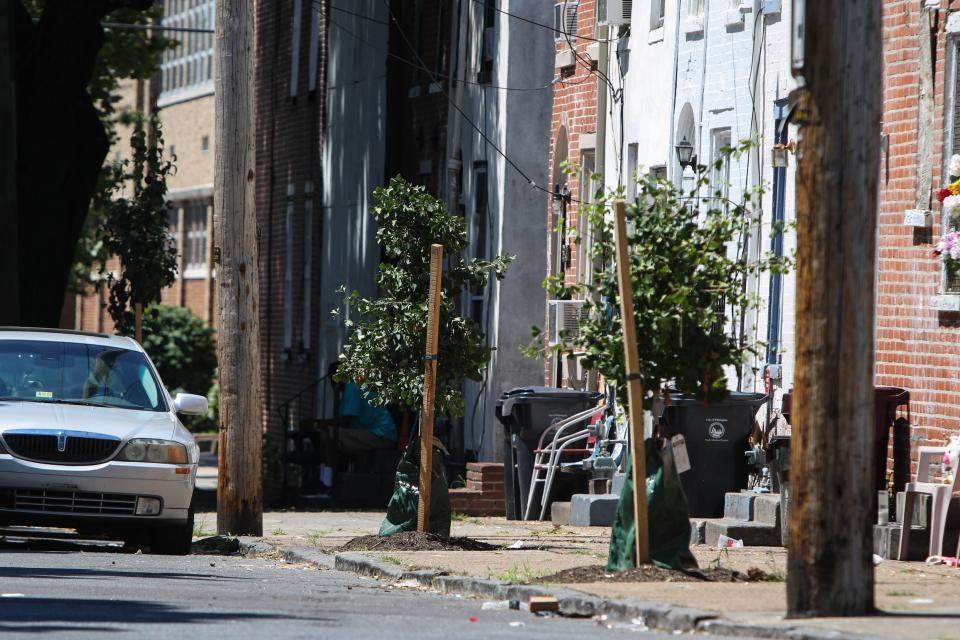Not all Wilmington neighborhoods experience the same summer heat. Here’s why.
Steel fences broke the asphalt sea from all sides.
Humidity hung from bright-yellow bars and silent playground equipment. This afternoon in July — forecast to peak a heat wave stretching nearly a week — the playset was left to bake. No children yelled; no staff or parents kept watch. Heat index factored, West Center City in Wilmington felt like 109 degrees.
A few blocks away, a spray park drizzled mist under the same beating sun. Still, it stood empty.
The official temperature recorded for Wilmington by the National Weather Service in these moments would have been about 94 degrees, measured some 6 miles away at New Castle Airport. Farther northeast, temperatures in the Highlands neighborhood edged past 98 degrees.
The story is different here. Miles away from any coastline, residents are stranded on an urban heat island — area where dense concentrations of dark materials like asphalt, steel and brick trap heat between buildings and streets.
“I don’t stay out long,” Vicky Holden said.
Following the bends in shade, small pockets of people gathered in the West Center City’s one-block park. While Holden’s friends dispersed after a lunch of crabs, she lingered at the wooden picnic table outside Helen Chambers Playground.
The canopy edging West Sixth Street above her joins just 20% tree cover in the neighborhood. Wilmington’s tree coverage is as high as 70% in wealthier areas and as low as 10% in others, as previously reported by Delaware Online/The News Journal. The average is about 22%.
“It’s just too hot,” said the West Center City resident, still under the shade. “I have to leave the house. I’m going crazy staying in the house — but it’s too hot to be out here.”
After tossing her paper dishes, Holden will escape to the air conditioning once more. For her, the resource is growing more expensive than ever.
NATIONAL:We created scorching 'heat islands' in East Coast cities. Now they're becoming unlivable
Wilmington now sees an average of seven more days a year over 90 degrees than it did 50 years ago. But aside from citywide temperatures getting hotter, one could just look at Holden’s ZIP code.
Neighborhoods like hers — those with little shade, large expanses of concrete and buildings, few trees and fewer parks — will now find heat enhanced in the day’s hottest hours. Perhaps more insidious, the same surfaces will release heat slowly over the course of the night, making the cooler evening hours hotter than they should be. This is urban heat island effect.
Even without pocket thermometers, you can feel the difference across neighborhoods.
It may not be surprising, looking at a partly shady 98 degrees on the left, vs 101 on the right — but West Center City would “feel like” 109 degrees today. pic.twitter.com/anirGFmWCt— Kelly Powers (@kpowers01) July 24, 2022
Delaware is tied with Arizona as the fourth-fastest warming state in the United States based on temperature trends since 1970. Average temperatures in Delaware are projected to increase 2.5 to 4.5 degrees by 2050, from 2012 averages. That could rise up to 8 degrees by 2100, in the worst emissions scenario, according to the Delaware Department of Natural Resources and Environmental Control.
And heat islands will be 1 to 7 degrees hotter than the rest of their city.
Dangerous heat not felt equally
Historically, any day above 100 degrees would be rare in Delaware.
Days like that would typically have come just about once a year if that. But by 2050, the state’s Climate Action Plan warns of two to eight each year, alongside projections of up to five nights with temperatures above 80. That used to occur fewer than one night per decade.
Climate change has exacerbated heat wave intensity. The average length of a heat wave season is now around 70 days, compared with the 1960s when it lasted around 20 days. And today, excessive heat claims more lives every year on average than any other weather hazard in the country. More than flooding and hurricanes combined, and more than tornadoes.
A difference of a few degrees in extreme heat can affect the body’s ability to regulate. Extended exposure adds stress to the body’s organs. Those with respiratory illnesses, diabetes and obesity are at the highest risk.
NEW:Subsidized loans available for Delawareans impacted by redlining after $20M settlement
And the summer heat is affecting low-income communities and people of color on a greater scale.
On average, a person of color lives in a census tract with higher surface urban heat island intensity than non-Hispanic white people in all but six of the 175 largest U.S. metro areas, as reported in an extensive USA TODAY Network project. Black residents had the most exposure to these effects, according to a 2021 study, followed by Hispanic people.
These statistics can trace as far back as racist housing practices like local developers or homeowner association “covenants,” as well as "redlining" — referring to a since-outlawed policy that singled-out neighborhoods that were deemed especially risky to investors, most often because they were largely non-white — that resulted in isolation and lack of investment.
Wilmington would offer no exception.
The entire city is particularly susceptible to heat island effect, with about 60% impervious surfaces, according to a recent city climate study. Summer temperatures on the East Side, Baynard Boulevard and Browntown-Hedgeville neighborhoods often exceed 100 degrees as well.
According to a recent economic analysis released in July exploring climate change impact statewide, Wilmington alone will feel the greatest damage from increasing heat.
Certain impacts driven by rising temperatures — worsened water quality; lung and respiratory disease; cost to roads, rails and bridges; heat-related mortality and morbidity — combine to about $36 billion in statewide economic loss projected by the end of the century, in the study's high-emissions scenario. These impacts lessen by about 48% on average, across categories, in a scenario with emissions lowered.
Holden is out every day in West Center City.
“I come out here to sit for a minute,” she said, rising to leave her spot in the park.
“I might go back every now and then, but it's hot out here. And it’s a shame. I don’t know how we’re surviving in this God-darn community.”
What can cities do about it?

Tara Trammell knows there isn’t one simple solution.
The urban forestry expert with the University of Delaware said planting trees in underinvested neighborhoods can be helpful, but advocates must remember it's a complex solution. Not all trees can thrive, and they come with maintenance, money and risks.
Wilmington has identified greenery as a long-term solution to combat heat island effect in its most recent climate risk study with DNREC — hoping to incentivize tree planting and “green roof” installation by streamlining approval processes. The mayor’s office told Delaware Online/The News Journal that the city allots about $70,000 a year in federal grant funds to plant trees in low-income neighborhoods. The Delaware Center for Horticulture leads that charge.
“It’s important to work with communities individually,” cautioned Trammell, whose research has not brought her into Wilmington specifically but other urban centers on the East Coast. “If we want to use green infrastructure — which, trees could be really beneficial — then engaging the community, understanding and providing support once we do our tree planting projects, being able to maintain those trees.”

DNREC experts also pointed out the need to review the effectiveness of cooling centers, both formal and informal, throughout the city.
Access to cooling centers has been shown to dramatically reduce extreme temperature mortality, according to another Delaware study, but their use can be limited by access, lack of availability or unwillingness of vulnerable populations to use the centers.
Right now, a Wilmington program allows older adults to request free fans in the worst of summer heat. The city also maintains several spray parks, open all week, alongside a list of public pools. Informal cooling centers, like the William “Hicks” Anderson Community Center in West Center City, also allow for cooling down.
Water advisory at Rehoboth Beach:What to know about bacteria levels
More: What is the heat index?
Holden thinks people should consider passing out cold water at community centers or parks like hers — but above all, having more areas to escape the hot sun is crucial.
“I mean, even though it's hot, you’ve got to come outside,” she said. “Chatting with people you know: We need our park.”
This story is part of an extensive USA TODAY Network project called "Perilous Course," a collaborative examination of how people up and down the East Coast are grappling with the climate crisis. Journalists from more than 30 newsrooms from Florida to New Hampshire are speaking with regular people about real-life impacts, digging into the science and investigating government response, or lack of it.
This article originally appeared on USA TODAY NETWORK: Why some Wilmington neighborhoods strand locals on urban heat islands

